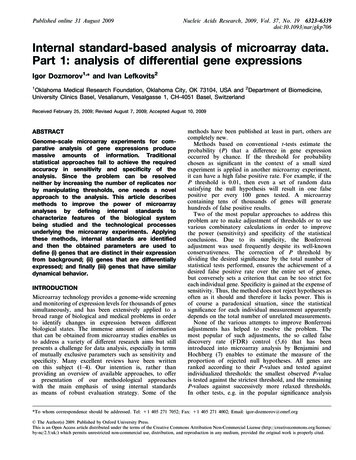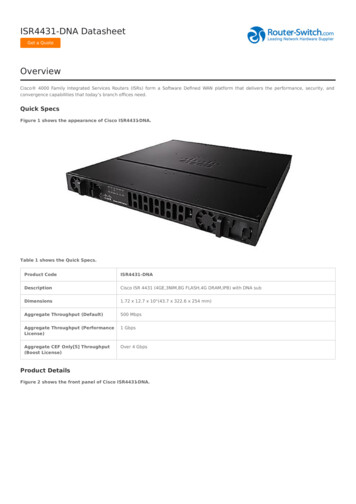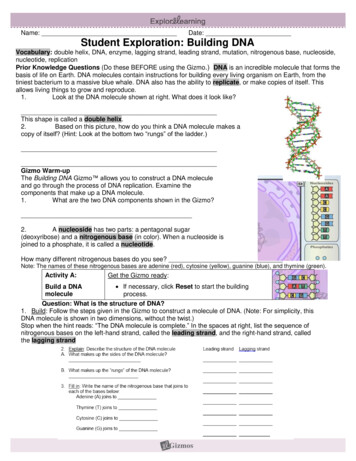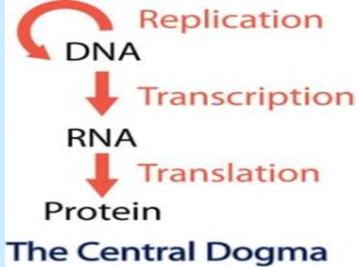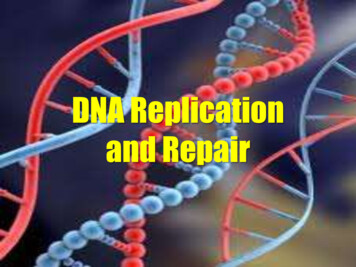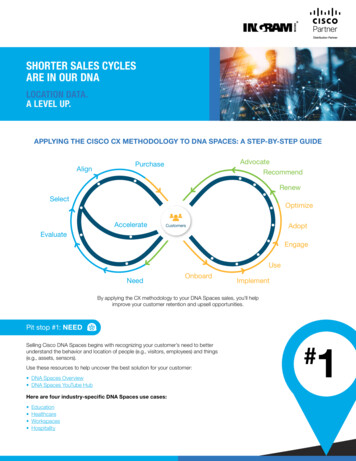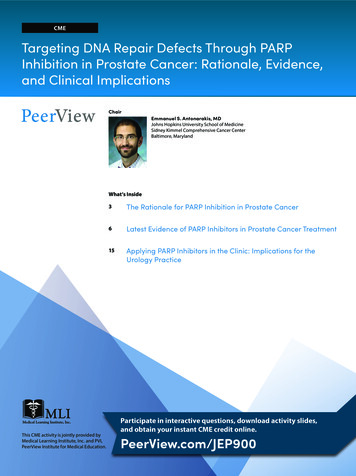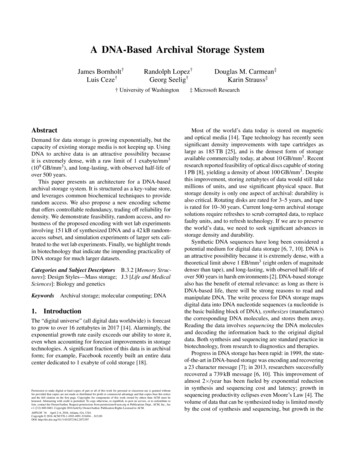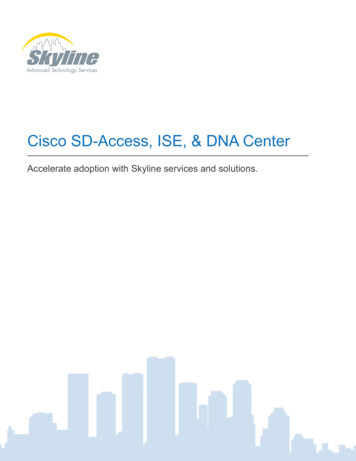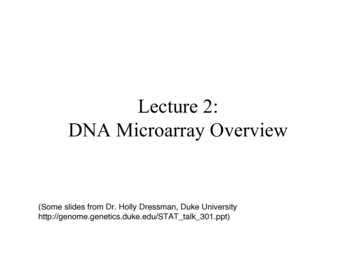
Transcription
Lecture 2:DNA Microarray Overview(Some slides from Dr. Holly Dressman, Duke Universityhttp://genome.genetics.duke.edu/STAT talk 301.ppt)
Announcements Go to class web pagehttp://www.cs.washington.edu/527– Add yourself to class list– Check out HW1, including last year’s CSE 590CB Org. meeting today,3:30 MEB 243http://www.cs.washington.edu/590cb
Talks Dr. Martin Tompa, UW "Tools for Prediction ofRegulatory Elements in Microbial Genes"– Combi Seminar: Wed 10/6 1:30, K-069– CSE Seminar: Tue 10/12 3:30, EE-105 Dr. Michal Linial, Hebrew University, “The ProteinFamily Tree: Making Biological Sense From SequenceData”– CSE Seminar:Thu 10/7 3:30 pm, EE-105
Gene Expression:The “Central Dogma”DNA RNA ProteinProteinDNARNAcell(messenger)
Gene Expression Proteins do most of the workThey’re dynamically created/destroyedSo are their mRNA blueprintsDifferent mRNAs expressed at differenttimes/places Knowing mRNA “expression levels” tells alot about the state of the cell
MicroarraysA snapshot that captures the activitypattern of thousands of genes at once.Custom spotted arraysAffymetrix GeneChip
Expression Microarrays The Array– Thousands to hundreds of thousands of spotsper square inch– Each holds millions of copies of a DNAsequence from one gene Its Use– Take mRNA from cells, put it on array– See where it sticks – mRNA from gene xshould stick to spot x
An Expression Array ExperimentcellsuvarraymRNA
An Example Application 72 leukemia patients– 47 ALL– 25 AML 1 chip per patient 7132 human genes per chipGolub, et al., Science 286:531-537 (1999).
Key Issue:What’s Different? What genes are behaving differentlybetween ALL & AML(or other disease/normal states)? Potential uses:––––DiagnosisPrognosisInsight into underlying biology/biologiesTreatment
A Classification Problem Given an array from a new patient: is it ALL orAML? Many possible approaches:LDA, logistic regression, NN, SVM, Problems:– Noise– Dimensionality
An Example Application Yeast “Sporulation”7 time points over 18 hoursOne array per time pointAll 6200 yeast genes on eachChu, DeRisi, Eisen, Mulholland, Botstein, Brown, Herskowitz, “The TranscriptionalProgram of Sporulation in Budding Yeast,” Science, 282 (Oct 1998) 699-705
An Example Application Yeast “Sporulation”7 time points over 18 hoursOne array per time pointAll 6200 yeast genes on each3-10x increase in number of genes knownto be involved in sporulation, many withrecognizable analogs in humans, presumablykey players in egg/sperm formationChu, DeRisi, Eisen, Mulholland, Botstein, Brown, Herskowitz, “The TranscriptionalProgram of Sporulation in Budding Yeast,” Science, 282 (Oct 1998) 699-705
Other Applications Study gene function & regulation– Covarying coregulated?– Covarying common pathway? Refined categorization of diseases– E.g., "prostate cancer" is almost certainly notone disease. Are subtypes distinguishable atexpression level?
Practical Applications of MicroarraysGene Target Discovery- Diseased vs normal cell comparison suggests sets of genes having key roles.- Over/underexpressed genes in the diseased cells can suggest drug targetsPharmacology and Toxicology- Highly sensitive indicator of a drug’s activity (pharmacology)and toxicity (toxicology) in cell culture or test animals.- Screen or optimize drug candidates prior to costly clinical trials.Diagnostics- Potential to diagnose clinical conditions by detecting gene expressionpatterns associated with disease states in either biopsy samples orperipheral blood cells.
Microarray Technologies Oligo Arrays– Affymetrix one color Short oligos match/mismatch– Agilent, inter alia 2 color Longer oligos Spotted cDNA arrays
GeneChip Probe Array
GeneChip Probe Arrays GeneChip Probe ArrayHybridized Probe CellSingle stranded, fluorescentlylabeled DNA targetOligonucleotide probe1.28cm*****24µmEach probe cell or feature containsmillions of copies of a specificoligonucleotide probeOver 250,000 different probescomplementary to geneticinformation of interestImage of Hybridized Probe Array
How unique is a 20-mer? VERY CRUDE model: DNA is random—everyposition is equally likely to be A, C, G, or T,independent of every other Then probability of a random 20-mer is44204010' 411' '1 '1 ' ' !3! 12' %" %%% " % " % "" " ( %10 " 10%& 2 # "&#& 4#& 2#& & 1024 # #&# So, a specific 20-mer occurs in random humansized DNA sequence with probability about 3 x109 x 10–12 .003
How Random is a Genome? G/C content can vary from 40-60% across and withinorganisms ("isochores") Adjacent pairs not independent Adjacent triples not independent (esp. in genes) Many large-scale repeats, e.g.– similar genes, domains within genes– transposons & other junk within primates, 5% of all DNA is composed of (noisey) copies ofa 300bp ALU sequence Nevertheless, crude model above is a useful guide
Probe Tiling StrategyGene Expression(25-mer)
Gene ExpressionTiling StrategyUninducedInduced40 separate hybridization events are involved indetermining the presence or absence of a transcript80 separate hybridization events are involveddetermining differential gene expression between twosamples
Synthesis of OrderedOligonucleotide ArraysLight(deprotection)MaskOOOOOTTOOOHO HO O O CGTTCCOTTOOOSubstrateC–REPEAT
Spotted Microarray Process
GenePix Pro Features Auto AlignBefore Auto AlignAfter Auto Align
P pixel intensityF feature intensityB background intensityRp ratio of pixel intensitiesRm ratio of meansmR median of ratiosrR regression ratio
Spotted glass slide microarraysAdvantagesLow cost per arrayCustom gene selectionAny speciesCompetitive hybridizationOpen architectureDisadvantagesClone managementClone costQuality control
Affymetrix GeneChip systemAdvantagesStream line productionLarge number of genes and ESTs/chipSeveral number of speciesDisadvantagesSystem costGeneChip costPropietary systemLimits on customizing
Micro Array Noise Sources Lot-to-lot variation (chips, reagents, ) Experiment-to-experiment variation– cell state, culture purity– sample preparation, hybridization conditions Spot-to-spot variation––––– unequal dye encorporationdye nonlinearity/saturationuneven spot sizesself- & cross-hybridizationImage capture & processing (spot finding, quantization, sensors)
Challenges in analyzing Microarray Data Amount of DNA in spot is not consistent Spot contamination cDNA may not be proportional to that in the tissue Low hybridization quality Measurement errors Spliced variants Outliers Data are high-dimensional “multi-variant” Biological signal may be subtle, complex, non linear,and buried in a cloud of noise Normalization Comparison across multiple arrays, time points, tissues,treatments How do you reveal biological relationships among genes? How do you distinguish real effect from artifact?
Factors to consider in designingmicroarray experiments Need to do lots of control experiments-validate method Do replicate spotting, replicate chips, and reverse labelingfor custom spotted chips Do pilot studies before doing “mega chip” experiments Don’t design experiment without replication; nothing willbe learned from a single failed experiment Design simple (one-two factor) experiments,i.e. treatment vs. untreatment Understand measurement errors In designing Databases; they are useful ONLY if qualityof data is assured Involve statistical colleagues in the design stages of your studies
Microarray Summary Lots of variations–––––Glass, nylonLong, short DNA moleculesFab via photolithography, ink jet, robotRadioactive vs fluorescent readoutRelative vs absolute intensity Leads to diverse sensitivity, bias, noise, etc. But same bottom line:unprecedented global insight into cellular stateand function
The Microarray Biz.(circa 3/2001) Despite concerns above "In early 1997, scientists never envisionedlooking at more than 25 to 50 geneexpression levels simultaneously. Todayeverybody tells us that they want to look atthe whole genome." -- T.Kreiner, Affymetrics 45% annual growth rate 1999-2000
Talks Dr. Martin Tompa, UW "Tools for Prediction of Regulatory Elements in Microbial Genes" –Combi Seminar: Wed 10/6 1:30, K-069 –CSE Seminar: Tue 10/12 3:30, EE-105 Dr. Michal Linial, Hebrew University, “The P
